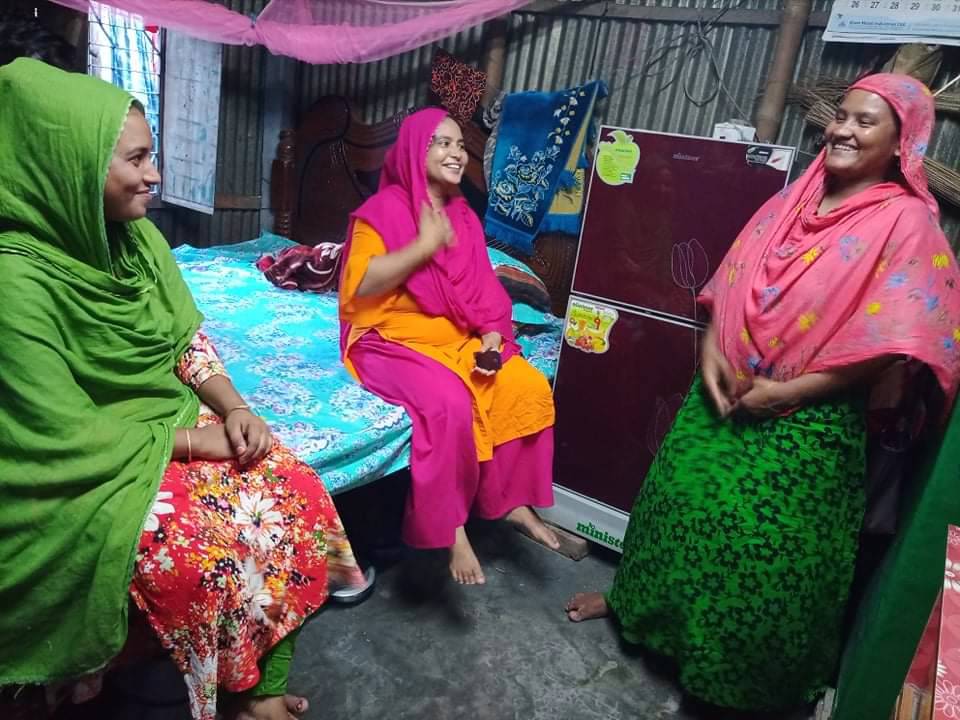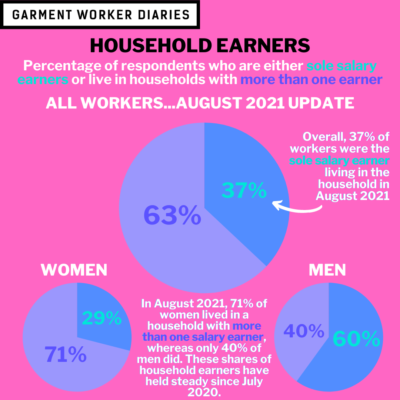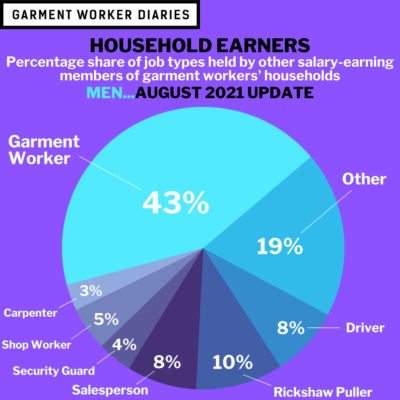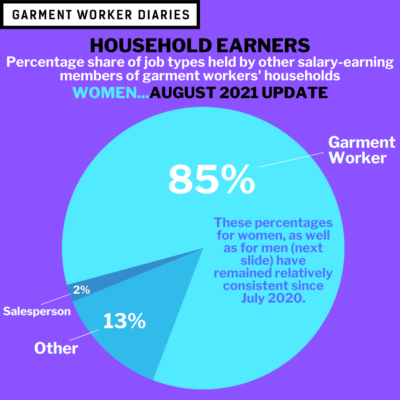In addition to the weekly interviews we conduct with our primary garment-working respondents in Bangladesh, MFO and SANEM have been continuing to gather economic data on those respondents’ other household members who are also wage earners. The story here over the past year is that the wage-earning makeup of garment workers’ households has basically not changed at all. Whether or not we should refer to this unchanging climate as one of “stability” is another matter, with all of the positive connotations that word evokes. Regardless, let’s get to the specifics on household earner data through the end of August 2021.
Note: Banner photo courtesy of a garment worker in Bangladesh; numbers in graphs and charts may not sum to 100% due to rounding.
Household Earner Work Hours, Wages and Demographics
In August 2021 the proportion of garment workers in our study who were the sole household earner, 37%, was very similar to our previous data updates. The share of women who were the sole household earner was 29%, compared to 60% of men.
Among the 63% of respondents who weren’t the sole household earner, 89% of those other household earners gave their consent allowing our respondents to discuss those other earner(s)’s household finances with MFO and SANEM (about the same percentage as had given consent for identical interviews over the past year). The employment rate of 97% among those other household earners in August 2021 remained hardly unchanged from previous report periods. The median hours worked by other household earners in August 2021 was 248, which was very similar to prior months (median work hours were only 200 in July 2021, but this is due to the Eid al-Adha break).
The median salary earned by other household earners in August 2021 was Tk. 10,500, which again remains largely unchanged from previous months. The typical salary for women was Tk. 10,000 and for men it was Tk. 11,000. This is similar to the typical incomes among workers in our general respondent pool, in that men almost always earn more than women.
The demographic makeup of the other household earners and the share of job types remained very consistent in August 2021 compared to past reporting months. One of the only noticeable movements is the share of other household earners who are spouses, which has continued to tick up slightly over the past year.
Proportional Breakdown of Other Household Earners
|
Household Member |
August 2021 |
May 2021 |
March 2021 |
December 2020 |
July 2020 |
|
Spouse |
77% |
77% |
76% |
74% |
71% |
|
Son |
6% |
5% |
5% |
6% |
5% |
|
Brother |
3% |
4% |
4% |
5% |
6% |
|
Father |
4% |
5% |
5% |
5% |
6% |
|
Mother |
3% |
3% |
3% |
3% |
4% |
|
Sister |
3% |
3% |
3% |
3% |
6% |
|
Daughter |
3% |
2% |
2% |
2% |
2% |
|
Other |
1% |
1% |
1% |
1% |
1% |
|
Brother-in-law |
0% |
0% |
0% |
0% |
0% |
|
Cousin |
0% |
0% |
0% |
0% |
0% |
And finally, the share of jobs that other household earners perform has also hardly changed over the past year. Basically, the vast majority of women continue to work in the garment sector, while men hold a wider variety of jobs.
Proportional Breakdown of Other Household Earner Job Types
|
Type of Job |
August 2021 |
May 2021 |
March 2021 |
December 2020 |
July 2020 |
||||||||||
|
All |
Women |
Men |
All |
Women |
Men |
All |
Women |
Men |
All |
Women |
Men |
All |
Women |
Men |
|
|
Garment Worker |
51% |
85% |
43% |
52% |
87% |
44% |
50% |
89% |
41% |
51% |
87% |
42% |
51% |
87% |
42% |
|
Driver |
7% |
0% |
8% |
8% |
0% |
9% |
7% |
1% |
9% |
7% |
0% |
9% |
5% |
0% |
7% |
|
Carpenter |
2% |
0% |
3% |
2% |
0% |
3% |
3% |
0% |
3% |
2% |
1% |
3% |
3% |
0% |
3% |
|
Salesperson |
7% |
2% |
8% |
6% |
2% |
7% |
6% |
0% |
7% |
6% |
0% |
8% |
5% |
0% |
7% |
|
Shop Worker |
4% |
0% |
5% |
3% |
0% |
3% |
4% |
0% |
6% |
4% |
0% |
5% |
2% |
0% |
3% |
|
Rickshaw Puller |
8% |
0% |
10% |
6% |
0% |
8% |
6% |
0% |
7% |
5% |
0% |
6% |
7% |
0% |
9% |
|
Security Guard |
4% |
0% |
4% |
3% |
0% |
4% |
2% |
0% |
3% |
3% |
0% |
4% |
3% |
0% |
4% |
|
Other |
18% |
13% |
19% |
21% |
11% |
23% |
21% |
10% |
24% |
22% |
12% |
24% |
23% |
13% |
26% |
The household earner data presented here come from interviews conducted over the phone from July 2020 through August 2021 with a pool of 1,297 workers. These workers are employed in factories spread across the five main industrial areas of Bangladesh (Chittagong, Dhaka City, Gazipur, Narayanganj, and Savar). Just over three-quarters of the working respondents are women, roughly representative of workers in the sector as a whole.



